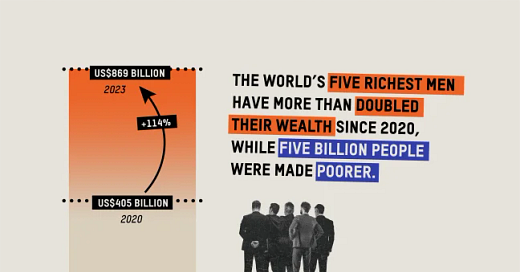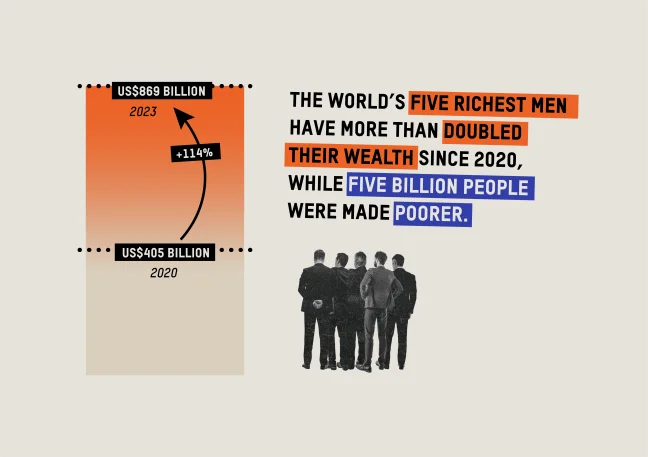Inequality Inc: Oxfam
Since 2020, the richest five men in the world have doubled their fortunes. During the same period, almost five billion people globally have become poorer. Hardship and hunger are a daily reality for many people worldwide. At current rates, it will take 230 years to end poverty, but we could have our first trillionaire in 10 years.
A huge concentration of global corporate and monopoly power is exacerbating inequality economy-wide. Seven out of ten of the world’s biggest corporates have either a billionaire CEO or a billionaire as their principal.
Sharply increasing billionaire wealth and rising corporate and monopoly power are deeply connected. The profits of mega-corporations are in turn used to benefit shareholders, at the expense of workers and ordinary people.
Using data from Wealth X, we have found that the richest 1% own 43% of all global financial assets.30 In the Middle East, the richest 1% hold 48% of financial wealth; in Asia, the richest 1% own 50% of wealth; and in Europe, the richest 1% own 47% of wealth.
This report uses new data to demonstrate that the richest people are not only the biggest beneficiaries of the global economy but exercise significant control over it too. New research by Oxfam illuminates just how much of the world’s financial assets are owned by the top 1%.
Looking at the 50 biggest public corporations in the world, billionaires are either the principal shareholder or the CEO of 34% of these corporates, with a total market capitalisation of US$13.3 trillion.31, 32
Billionaire owners use this control to ensure that corporate power is constantly growing through increasing market concentration and monopoly, enabled by government. This increased corporate power is in turn focused on providing ever-greater returns to them, the shareholders, at the expense of everyone else.
DOWNLOAD THE FULL REPORT
INEQUALITY-INC-Oxfam-Report-2024Download
For most people around the world, the start of this decade has been incredibly hard. At the time of writing, 4.8 billion people are poorer than they were in 2019. For the poorest people, who are more likely to be women, racialised peoples, and marginalised groups in every society, daily life has become more brutal still. Global inequality – the gap between Global North and the Global South – has grown for the first time in 25 years.
Prices are outpacing pay the world over, with hundreds of millions of people seeing their wages buy less each month and their prospects of a better future disappear. Protests and strikes by workers have repeatedly made the news headlines and filled the front pages.
Governments are finding it impossible to stay financially afloat in the face of mounting debt and the escalating costs of importing fuel, food and medicines. Low- and lower-middle-income countries are set to pay nearly half a billion US dollars a day in interest and debt payments between now and 2029, and they are having to make severe cuts to spending to be able to pay their creditors.
Meanwhile, the dramatic increase in extreme wealth witnessed since 2020 has become set in stone. Billionaires are now US$3.3 trillion or 34% richer than they were at the beginning of this decade of crisis, with their wealth growing three times as fast as the rate of inflation.
This wealth is concentrated in the Global North. Only 21% of humanity lives in the countries of the Global North, but these countries are home to 69% of private wealth, and 74% of the world’s billionaire wealth.27
The other big winners in this period of crisis are global corporations. For huge corporations, just as for super-rich individuals, the last two decades have been extraordinarily lucrative and the last few years have been better still: the biggest firms experienced an 89% leap in profits in 2021 and 2022.
New data shows that 2023 is set to shatter all records as the most profitable yet. Eighty-two percent of these profits are used to benefit shareholders, who are overwhelmingly
among the richest people in every society.
DOWNLOAD THE FULL REPORT
INEQUALITY-INC-Oxfam-Report-2024Download






